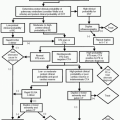Abdominal Abscess
Marcus W. Parker
D. Darrell Vaughn
Intra-abdominal abscesses occur most commonly after bowel perforation, surgery, trauma, pancreatitis, and in immunocompromised patients. Mortality can reach 30%. Intraabdominal abscesses can be divided according to location: intraperitoneal, retroperitoneal, and visceral.
Symptoms and Signs.
Development of an abscess is often insidious, and the clinical picture is often confusing and nonspecific. Patients with abdominal abscesses usually present with fever, leukocytosis, and an elevated erythrocyte sedimentation rate. Secondary findings include pain near the abscess, anorexia, weight loss, nausea, vomiting, altered bowel habits, and occasionally a palpable mass. However, few signs and symptoms may be present if the patient is immunosuppressed, taking steroids or antibiotics, or has a chronic, walled-off abscess.
Causes and Locations
Intraperitoneal Abscesses
Most commonly due to generalized peritonitis.
Form most frequently within the pelvis (66% of intra-abdominal abscesses).
Subphrenic and subhepatic spaces are the next most common sites. Subphrenic abscesses occur three times more often on the right than the left due to the natural flow of intraperitoneal fluid.
Other sites include infracolic and paracolic gutters, lesser sac.
Retroperitoneal Abscesses
Anterior pararenal space between the posterior peritoneum and anterior renal fascia caused by pancreatitis or perforated retroperitoneal bowel.
Perinephric space between the anterior and posterior layers of the renal fascia due to rupture of renal parenchymal abscesses through the renal capsule.
Visceral Abscesses
Hepatic abscesses can be due to bacterial seeding from diverticulitis, appendicitis, or endocarditis. Direct extension of cholecystitis-causing hepatic abscess can also occur. Fungal infections of the liver or spleen are often small and have a target appearance. Echinococcal or amebic abscesses may also occur.
Splenic abscesses are uncommon and when present they are often the result of uncontrolled, widespread infection. They may also be sequela of splenic infarct or trauma. Ultrasonography can help differentiate a splenic infarct from a true abscess.
Pancreatic abscesses are usually the sequela of acute pancreatitis and occur at sites of pancreatic necrosis.
Renal cortical abscesses often occur as a result of hematogenous spread of Staphylococcus.
Renal medullary abscesses are most frequently a complication of acute pyelonephritis.
Differential Diagnosis.
Any low-attenuation or cystic mass may mimic an abscess including a cyst, pseudocyst, loculated ascites, hematoma, urinoma, lymphocele, biloma, thrombosed aneurysm, or necrotic neoplasm. Normal structures such as stomach, bowel, and bladder can also be confused with abscesses.
Indication.
Initial examination for generalized abdominal pain of unknown etiology. If localizing symptoms are present, patient is acutely ill, or there is a high clinical suspicion for abscess, the patient should have a computed tomographic (CT) scan.
Protocol.
Routine upright and supine abdominal views. Decubitus views or cross-table lateral for patients unable to sit upright.
Possible Findings
Radiographs have poor sensitivity for detecting abdominal abscess. Look for extraluminal air and air-fluid levels. If an abscess is suspected, additional imaging is usually required to confirm location and extent.
Stay updated, free articles. Join our Telegram channel

Full access? Get Clinical Tree



